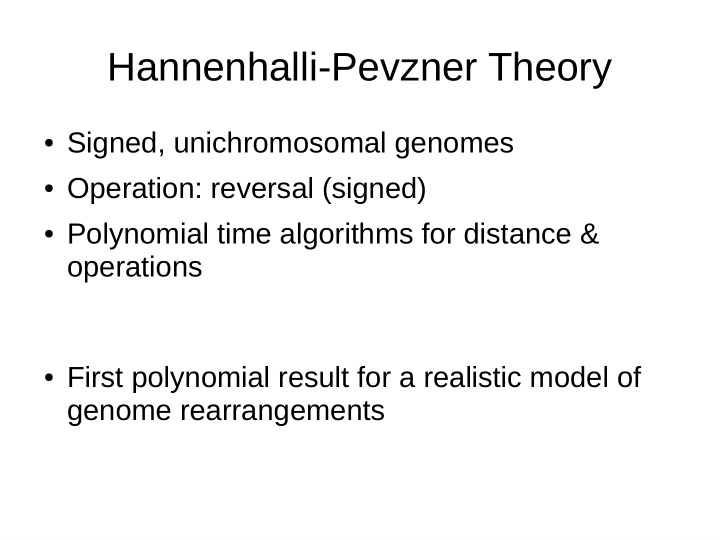



Hannenhalli-Pevzner Theory ● Signed, unichromosomal genomes ● Operation: reversal (signed) ● Polynomial time algorithms for distance & operations ● First polynomial result for a realistic model of genome rearrangements
HP Theory ● Genomes modeled as “permutations” ● What they call “permutations” are not functions from E to E ● Rather, they are functions from P (positions) to E (extemities) ● P = {1, 2, 3, …, n} ● E = {1, 2, 3, …, n, -1, -2, -3, …, -n} ● π : P → E
HP Theory ● Reversals are permutations on P ● ρ : P → P ● Reversals are applied to the right : πρ ● It is the only composition that makes sense ● Reversals do not always have small support
HP Theory ● Linear and circular cases are equivalent ● Extending the genome with 0 and n+1 essentially transforms the problem into a circular one ● In transforming π to σ, they fix σ: σ = 1 2 3 … n or σ(x) = x for all x σ is the “identity” ● The problem is then called “sorting” π
HP Theory ● Formula: d(π) = b(π) – c(π) + h(π) + f(π) h(π) = number of hurdles of π { 0 otherwise 1 π is a fortress f(π) = ● Algorithms O(n 4 ) and O(n 5 ), later improved
Elementary HP Theory ● Oriented pairs ● Score ● Algorithm 1: perform oriented reversals with maximum score as long as possible
Elementary HP Theory ● After Algorithm 1, one ends up with a “positive permutation” ● Reduced “permutations” ● Framed intervals ● Hurdles: cutting and merging
Elementary HP Theory ● Algorithm 2: ● 2k hurdles: – merge two hurdles, nonconsecutive if possible ● 2k + 1 hurdles: – simple hurdle: ● cut it – no simple hurdle: ● merge two hurdles, nonconsecutive if possible
Elementary HP Theory ● Algorithm 2, simplified: ● 2k + 1 hurdles and simple hurdle: – cut it ● Else: – merge two hurdles, nonconsecutive if possible
Elementary HP Theory ● Final algorithm: ● while π is unsorted do – Algorithm 1 – Reduce – Algorithm 2
Recommend
More recommend